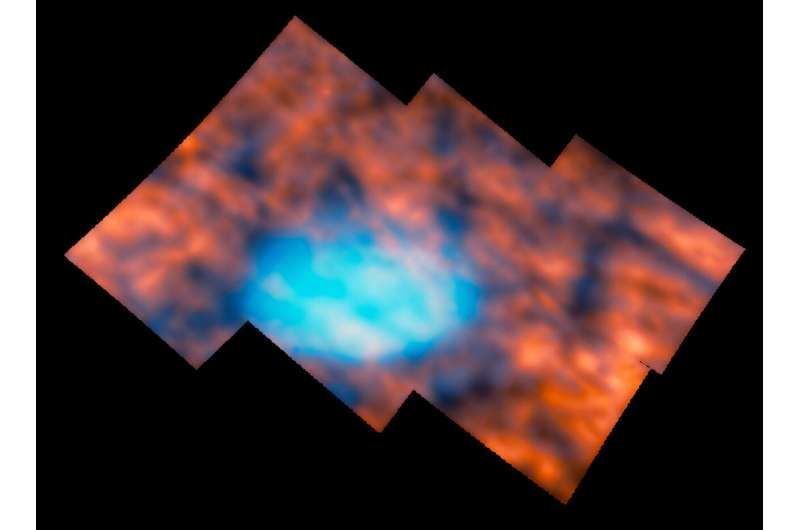Using the NASA/ESA/CSA James Webb Space Telescope, scientists observed the region above Jupiter’s iconic Great Red Spot to discover a variety of previously unseen features. The region, previously believed to be unremarkable in nature, hosts a variety of intricate structures and activity.
Jupiter is one of the brightest objects in the night sky, and it is easily seen on a clear night. Aside from the bright northern and southern lights at the planet’s polar regions, the glow from Jupiter’s upper atmosphere is weak and is therefore challenging for ground-based telescopes to discern details in this region. However, Webb’s infrared sensitivity allows scientists to study Jupiter’s upper atmosphere above the infamous Great Red Spot with unprecedented detail.
The upper atmosphere of Jupiter is the interface between the planet’s magnetic field and the underlying atmosphere. Here, the bright and vibrant displays of northern and southern lights can be seen, which are fueled by the volcanic material ejected from Jupiter’s moon Io.
However, closer to the equator, the structure of the planet’s upper atmosphere is influenced by incoming sunlight. Because Jupiter receives only 4% of the sunlight that is received on Earth, astronomers predicted this region to be homogeneous in nature.
The Great Red Spot of Jupiter was observed by Webb’s Near-InfraRed Spectrograph (NIRSpec) in July 2022, using the instrument’s Integral Field Unit capabilities. The team’s Early Release Science observations sought to investigate if this region was in fact dull, and the region above the iconic Great Red Spot was targeted for Webb’s observations.
The team was surprised to discover that the upper atmosphere hosts a variety of intricate structures, including dark arcs and bright spots, across the entire field of view. The results have been published in Nature Astronomy.
“We thought this region, perhaps naively, would be really boring,” shared team leader Henrik Melin of the University of Leicester in the United Kingdom. “It is in fact just as interesting as the northern lights, if not more so. Jupiter never ceases to surprise.”
Although the light emitted from this region is driven by sunlight, the team suggests there must be another mechanism altering the shape and structure of the upper atmosphere.

“One way in which you can change this structure is by gravity waves—similar to waves crashing on a beach, creating ripples in the sand,” explained Henrik. “These waves are generated deep in the turbulent lower atmosphere, all around the Great Red Spot, and they can travel up in altitude, changing the structure and emissions of the upper atmosphere.”
The team explains that these atmospheric waves can be observed on Earth on occasion. However, they are much weaker than those observed on Jupiter by Webb. They also hope to conduct follow-up Webb observations of these intricate wave patterns in the future to investigate how the patterns move within the planet’s upper atmosphere and to develop our understanding of the energy budget of this region and how the features change over time.
These findings may also support ESA’s Jupiter Icy Moons Explorer, Juice, which was launched on 14 April 2023. Juice will make detailed observations of Jupiter and its three large ocean-bearing moons—Ganymede, Callisto and Europa—with a suite of remote sensing, geophysical and in situ instruments.
The mission will characterize these moons as both planetary objects and possible habitats, explore Jupiter’s complex environment in depth, and study the wider Jupiter system as an archetype for gas giants across the universe.
These observations were taken as part of the Early Release Science program #1373: ERS Observations of the Jovian System as a Demonstration of JWST’s Capabilities for solar system Science.
“This ERS proposal was written back in 2017,” shared team member Imke de Pater of the University of California, Berkeley. “One of our objectives had been to investigate why the temperature above the Great Red Spot appeared to be high, as at the time recent observations with the NASA Infrared Telescope Facility had revealed. However, our new data showed very different results.”
More information:
Henrik Melin et al, Ionospheric irregularities at Jupiter observed by JWST, Nature Astronomy (2024). DOI: 10.1038/s41550-024-02305-9
Provided by
European Space Agency
Citation:
Jupiter’s upper atmosphere surprises astronomers (2024, June 25)
retrieved 25 June 2024
from
This document is subject to copyright. Apart from any fair dealing for the purpose of private study or research, no
part may be reproduced without the written permission. The content is provided for information purposes only.